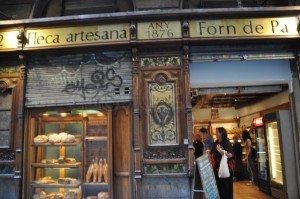Ever since my internship started I’ve had to accept to things: I won’t understand what people around me are saying because they suddenly switch from Spanish to Catalan midway through a conversation, and lunch is never eaten before 2.30 pm. Being used to munching already at midday, the second lifestyle adjustment was particularly painful as my stomache (loudly) protested against this sudden change and the rumbling it produced would sometimes overpower the pleasant ambiance music in the office. Nonetheless, I managed to power through and am now a master of the 3PM lunch. I usually bring food from home but was really late this morning so I had to just grab a ‘bocadillo’ (more commonly known as sandwiches) from the cafe’ just across the street. I opted for the classic ‘baguette with ham and tomato’:
The bread was made from a bakery on the very same street, the tomatoes come from the market closeby and the ham comes from Granada. I must say that finding this information wasn’t the easiest task ever, and I think the lady at the counter would have preferred I never entered her cafe’ that morning as I was asking about the origins of every food item I had ordered from her while she was juggling with other clients and making my deligthful sandwich.
The ham from Granada isn’t cooked, its cured. I looked into the specific process of how it is made in the region (http://www.interjamon.com/english/ijamongranada.asp) and typically a 7kg block must be cured for 12 to 14 months. The particular taste comes from being immersed in salt for the first few days and then the curing process and length which both interact with the climate. I was so surprised to find out that the same food ends up tasting different when cooked or produced at different altitudes!
The total production phase is as follows:
· Preliminary Process
· Bleeding
· Shaping, polishing and cutting
· Labelling
· Salting
· Post-salting
· Draining
· Drying
· Cure
· Maturing
· Aging
As one can immagine, the whole process is very time-consuming and much of the work is done by hand. The largest energy expenditure is due to the drying process, as the room has to be set at exactly 10-12 C and be kept at 70% humidity, and during the maturing process, when the room has to be set between 30-35 C and be kept at 60% humidity.
Granada is 992 km far from Barcelona, so my ham did quite a journey compared to the rest of my lunch. Now on to the other ingredients…
To make a loaf of bread, about 5200 watts are needed, which is equivalent to 2 hours of oven-baking, which in turn is equal to keeping a fluorescent lightbulb on nonstop for almost 22days!




